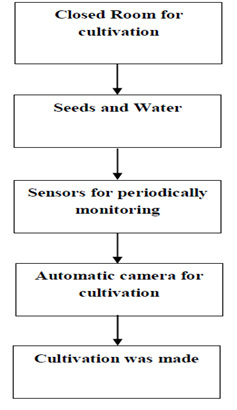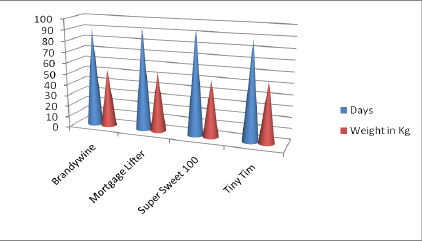Department of Computer Science and Engineering K. Ramakrishnan College of Engineering, Trichy, Tamil Nadu, India
Corresponding author Email: kiranit2010@gmail.com
Article Publishing History
Received: 21/10/2017
Accepted After Revision: 28/12/2017
In our proposed system we have taken various varieties of tomatoes like Brandywine, Mortgage Lifter, Super Sweet 100 and Tiny Tim for cultivation by using the hydroponics technology. Closed hydroponic systems provide the same nutrient solution which is re-circulated and the nutrient concentrations are monitored and adjusted accordingly. In open hydroponic systems a fresh nutrient solution was introduced for each irrigation cycle. The big challenge behind the hydroponics technique was to maintain the nutrient levels in water periodically, for which sensors were used to monitor and ensure that water level and minerals level were in correct propositions as the sensor is very important criteria in hydroponics technique to grow the plants.
Minerals, Sensors, Germination, Coco Peat, Seeds, Nutrient
Bala B. K, Kumar R. S. A Novel Method of Cultivation of Different Varieties of Tomato Without Using Soil. Biosc.Biotech.Res.Comm. 2017;10(4).
Bala B. K, Kumar R. S. A Novel Method of Cultivation of Different Varieties of Tomato Without Using Soil. Biosc.Biotech.Res.Comm. 2017;10(4). Available from: https://bit.ly/2XIdd3d
Introduction
Day by day our environment is getting polluted not only air, noise, water even soil also is getting polluted due to real estate issues so many agriculture land has been converted into plots (Nguyen et al. 2016). Due to nuclear waste has been mixed in soil example in Japan still cultivating the plants in soil that particular vegetables, fruits those who are eating they still get affected by diseases (Alaeldin et al. 2017). There are several plants which can be grown in the hydroponics technique even single plant has several types of seeds and variety will be there. In our proposed system we have taken tomato plant to cultivate by using the hydroponics technology (El-Kazzaz et al. 2017).
To cultivate the tomato in different types of varieties but without soil to grow the plant due to the pollution in soil to overcome the problem and also to analyze different type of proposition of minerals added to plant and to see the variation in plant grows and taste as well as to analyze any side effect will come in this type of plant or not, (Charumathi et al. 2017).
 |
Figure 1: Diagram for the system |
Day by day our environment is getting polluted both in soil as well as water. In soil there are two types of problems firstly, most of the rural cultivation lands are converting into real estate plots and the second is pollution of left over soil with waste dumping of agrochemicals, pesticides, and other pollutants which are mixing in the soil destroying the agriculture, as plants do not grow properly and will produce the less fruits as well as vegetables, along with several diseases and toxicological manifestations. To overcome these problems recent focus is on cultivation of plants without soil which gives better solution to the problems, (Bala et al. 2017a). In this proposal there is no simulation required to grow the plants, within a room making green house effect using different seeds in different proposition and there by growing plants (Bala et al. 2017b).
The basic need for the seeds are nutrients as we have directly added the nutrients to water by recycling the process and less water with more yield is the concept in the entire process. To identify the nutrient is very difficult task in the entire process. There are 7 sensors, which have been used to identify the level of the nutrients in the water level as per the ratio indication is available in the sensor itself.
 |
Figure 2: Showing yields of various tomato varieties in different days with their weight |
Selecting a room for growing plants. Selecting best seeds for cultivation and to design a sensor for implementation of this project. Using sensor concentration of the nutrient is identified; monitored and required feed is given for improving yield. By changing the variety of seeds as well as minerals/nutrient supplement for achieving result. There is a need of sensor to monitor the nutrient level in water so setup the minerals sensor is a major issue and to make automation of capturing the image is also a necessary think available and want to buy different types of seeds and in different environment along with necessary things. For establishing the experimental setup and to make the system automation there is a need of camera. To measure the minerals level there is a need for sensor which checks the nutrient level in the water to be pumped for growing the plants, also green house effect and electricity back up is mandatory for implementing this project. In the implementation part the entire process taken 95 days to cultivate the vegetables as per the proposed system. We have tried different types of seeds and total time taken for the yield was 95 days. In the closed system 10X10 SQ.M 53.33 Kg of tomato has been cultivated.
Growing the plants without soil as well as with low amount of water by recycling the same water and adding the nutrients directly to water and monitoring the nutrients level in water through sensor has been quite successful in the present study. In the proposed system same thing has been implemented but 7 sensors as well s different variety of tomato has been used for the cultivation.
References
- Alaeldin Abdallah Helaly 2017, Strategies for Improvement of Horticultural Crops against Abiotic Stresses J Hortic, 4:1.
- Charumathi,S R.M.Kaviya, J.Kumariyarasi, R.Manisha and P.Dhivya 2017, Optimization and Control of Hydroponics Agriculture using IOT, Asian Journal of Applied Science and Technology (AJAST) Volume 1, Issue 2, Pages 96-98.
- El-Kazzaz KA and AA El-Kazzaz 2017, Soilless Agriculture a New and Advanced Method for Agriculture Development: an Introduction, Agri Res & Tech: Open Access J 3(2):ARTOAJ.MS.ID.555610 , Pages 1-10.
- Kiran Bala B 2017, A Novel Approach to Generate a Key for Cryptographic Algorithm, Journal of Chemical and Pharmaceutical Sciences, Special Issue 2: February 2017, Pages 229-231.
- Kiran Bala B 2017, A Novel Approach to Identify the Micro calcification Images, Journal of Chemical and Pharmaceutical Sciences, Special Issue2: February 2017, Pages 190-192.
- Nga T. Nguyen, Samuel A. McInturf, and David G. Mendoza-Cózatl 2016, A Versatile System to Study Nutrient Allocation and Plant Responses to Nutrient Availability and Exposure to Toxic Elements, J Vis Exp.; (113): 54317.


